Input interpretation

xenon (chemical element) | antimony (chemical element) | tin (chemical element)
Periodic table location
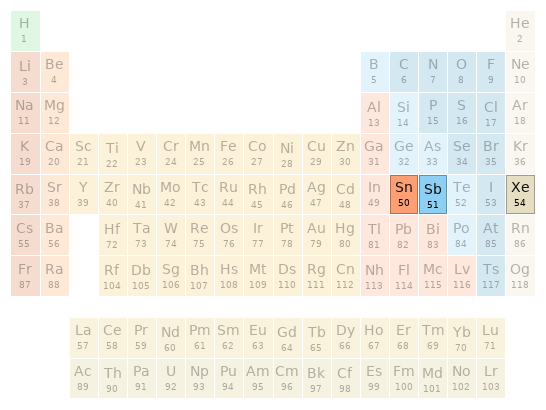
Periodic table location
Images
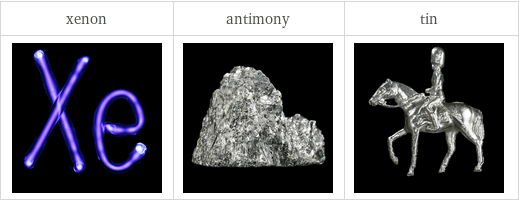
Images
Basic elemental properties
![| xenon | antimony | tin atomic symbol | Xe | Sb | Sn atomic number | 54 | 51 | 50 short electronic configuration | [Kr]5s^24d^105p^6 | [Kr]5s^24d^105p^3 | [Kr]5s^24d^105p^2 Aufbau diagram | 5p 4d 5s | 5p 4d 5s | 5p 4d 5s block | p | p | p group | 18 | 15 | 14 period | 5 | 5 | 5 atomic mass | 131.293 u | 121.76 u | 118.71 u half-life | (stable) | (stable) | (stable)](../image_source/d0926b5c02e83a15b8cc374638fd2a91.png)
| xenon | antimony | tin atomic symbol | Xe | Sb | Sn atomic number | 54 | 51 | 50 short electronic configuration | [Kr]5s^24d^105p^6 | [Kr]5s^24d^105p^3 | [Kr]5s^24d^105p^2 Aufbau diagram | 5p 4d 5s | 5p 4d 5s | 5p 4d 5s block | p | p | p group | 18 | 15 | 14 period | 5 | 5 | 5 atomic mass | 131.293 u | 121.76 u | 118.71 u half-life | (stable) | (stable) | (stable)
Thermodynamic properties
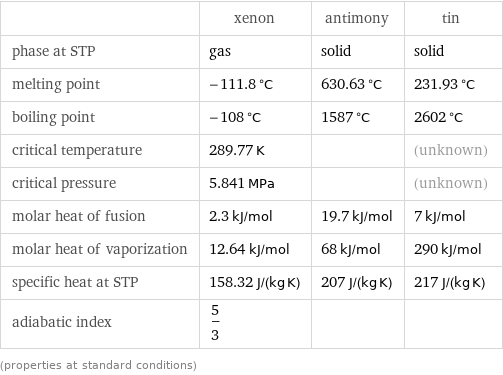
| xenon | antimony | tin phase at STP | gas | solid | solid melting point | -111.8 °C | 630.63 °C | 231.93 °C boiling point | -108 °C | 1587 °C | 2602 °C critical temperature | 289.77 K | | (unknown) critical pressure | 5.841 MPa | | (unknown) molar heat of fusion | 2.3 kJ/mol | 19.7 kJ/mol | 7 kJ/mol molar heat of vaporization | 12.64 kJ/mol | 68 kJ/mol | 290 kJ/mol specific heat at STP | 158.32 J/(kg K) | 207 J/(kg K) | 217 J/(kg K) adiabatic index | 5/3 | | (properties at standard conditions)
Material properties
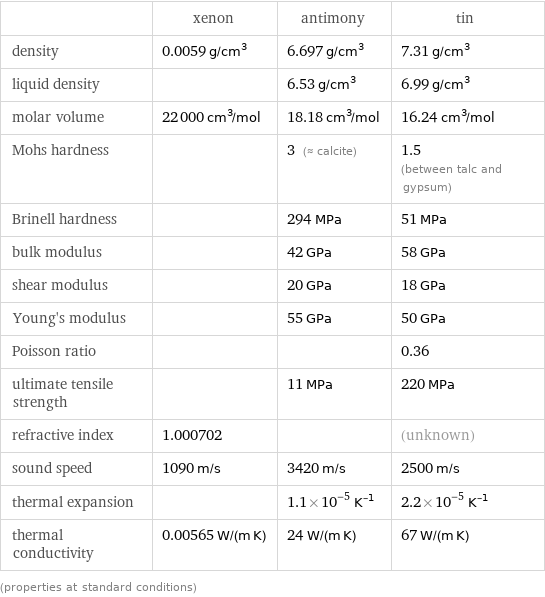
| xenon | antimony | tin density | 0.0059 g/cm^3 | 6.697 g/cm^3 | 7.31 g/cm^3 liquid density | | 6.53 g/cm^3 | 6.99 g/cm^3 molar volume | 22000 cm^3/mol | 18.18 cm^3/mol | 16.24 cm^3/mol Mohs hardness | | 3 (≈ calcite) | 1.5 (between talc and gypsum) Brinell hardness | | 294 MPa | 51 MPa bulk modulus | | 42 GPa | 58 GPa shear modulus | | 20 GPa | 18 GPa Young's modulus | | 55 GPa | 50 GPa Poisson ratio | | | 0.36 ultimate tensile strength | | 11 MPa | 220 MPa refractive index | 1.000702 | | (unknown) sound speed | 1090 m/s | 3420 m/s | 2500 m/s thermal expansion | | 1.1×10^-5 K^(-1) | 2.2×10^-5 K^(-1) thermal conductivity | 0.00565 W/(m K) | 24 W/(m K) | 67 W/(m K) (properties at standard conditions)
Electromagnetic properties
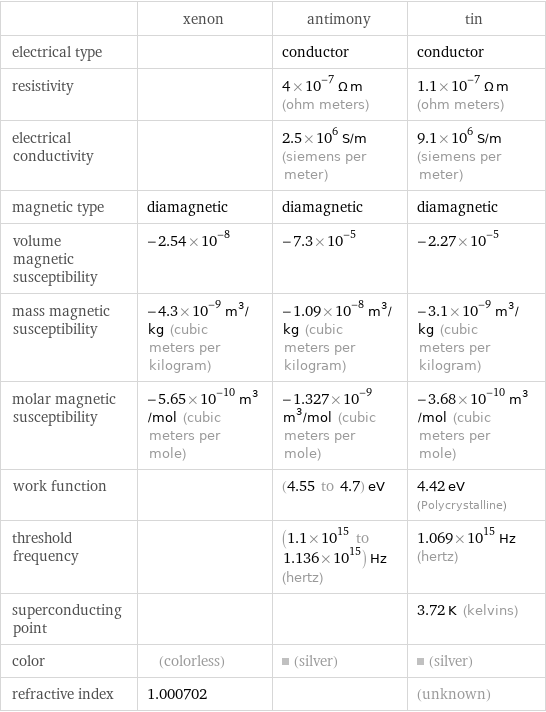
| xenon | antimony | tin electrical type | | conductor | conductor resistivity | | 4×10^-7 Ω m (ohm meters) | 1.1×10^-7 Ω m (ohm meters) electrical conductivity | | 2.5×10^6 S/m (siemens per meter) | 9.1×10^6 S/m (siemens per meter) magnetic type | diamagnetic | diamagnetic | diamagnetic volume magnetic susceptibility | -2.54×10^-8 | -7.3×10^-5 | -2.27×10^-5 mass magnetic susceptibility | -4.3×10^-9 m^3/kg (cubic meters per kilogram) | -1.09×10^-8 m^3/kg (cubic meters per kilogram) | -3.1×10^-9 m^3/kg (cubic meters per kilogram) molar magnetic susceptibility | -5.65×10^-10 m^3/mol (cubic meters per mole) | -1.327×10^-9 m^3/mol (cubic meters per mole) | -3.68×10^-10 m^3/mol (cubic meters per mole) work function | | (4.55 to 4.7) eV | 4.42 eV (Polycrystalline) threshold frequency | | (1.1×10^15 to 1.136×10^15) Hz (hertz) | 1.069×10^15 Hz (hertz) superconducting point | | | 3.72 K (kelvins) color | (colorless) | (silver) | (silver) refractive index | 1.000702 | | (unknown)
Reactivity

| xenon | antimony | tin valence | 6 | 5 | 4 electronegativity | 2.6 | 2.05 | 1.96 electron affinity | 0 kJ/mol (kilojoules per mole) | 103.2 kJ/mol (kilojoules per mole) | 107.3 kJ/mol (kilojoules per mole) first ionization energy | 1170.4 kJ/mol (kilojoules per mole) | 834 kJ/mol (kilojoules per mole) | 708.6 kJ/mol (kilojoules per mole) ionization energies | 1170.4 kJ/mol | 2046.4 kJ/mol | 3099.4 kJ/mol | 834 kJ/mol | 1594.9 kJ/mol | 2440 kJ/mol | 4260 kJ/mol | 5400 kJ/mol | 10400 kJ/mol | 708.6 kJ/mol | 1411.8 kJ/mol | 2943 kJ/mol | 3930.3 kJ/mol | 7456 kJ/mol
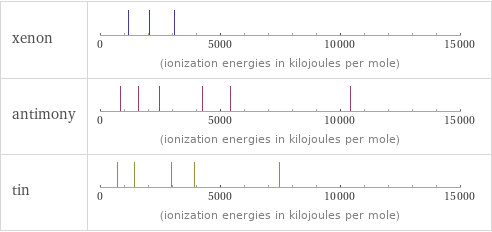
Reactivity
Atomic properties
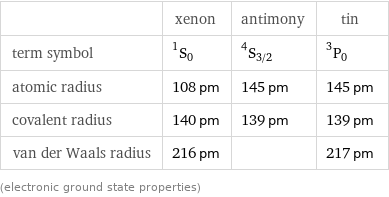
| xenon | antimony | tin term symbol | ^1S_0 | ^4S_(3/2) | ^3P_0 atomic radius | 108 pm | 145 pm | 145 pm covalent radius | 140 pm | 139 pm | 139 pm van der Waals radius | 216 pm | | 217 pm (electronic ground state properties)
Abundances
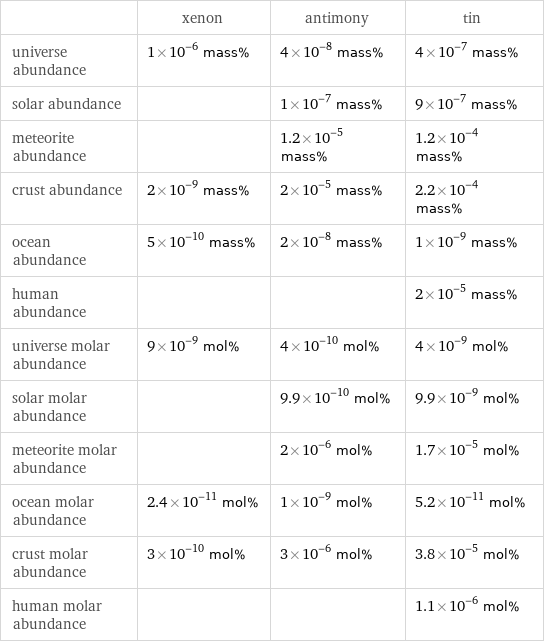
| xenon | antimony | tin universe abundance | 1×10^-6 mass% | 4×10^-8 mass% | 4×10^-7 mass% solar abundance | | 1×10^-7 mass% | 9×10^-7 mass% meteorite abundance | | 1.2×10^-5 mass% | 1.2×10^-4 mass% crust abundance | 2×10^-9 mass% | 2×10^-5 mass% | 2.2×10^-4 mass% ocean abundance | 5×10^-10 mass% | 2×10^-8 mass% | 1×10^-9 mass% human abundance | | | 2×10^-5 mass% universe molar abundance | 9×10^-9 mol% | 4×10^-10 mol% | 4×10^-9 mol% solar molar abundance | | 9.9×10^-10 mol% | 9.9×10^-9 mol% meteorite molar abundance | | 2×10^-6 mol% | 1.7×10^-5 mol% ocean molar abundance | 2.4×10^-11 mol% | 1×10^-9 mol% | 5.2×10^-11 mol% crust molar abundance | 3×10^-10 mol% | 3×10^-6 mol% | 3.8×10^-5 mol% human molar abundance | | | 1.1×10^-6 mol%